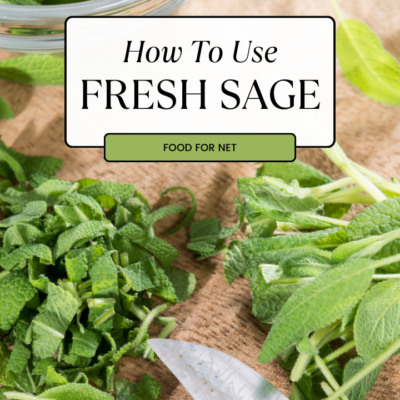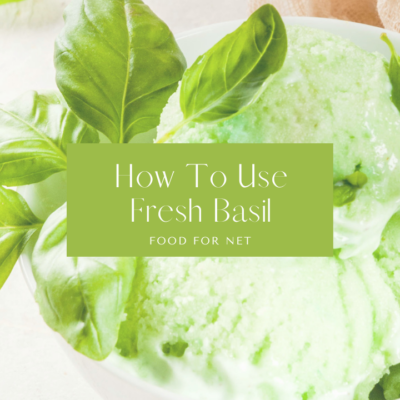
Mint is an exciting herb, as the menthol it contains creates a cooling sensation in the mouth, one that is both unusual and fantastic. There is also a slightly sharp and slightly sweet taste that’s difficult to describe and tastes amazing. What’s not to love?
These features are why fresh mint is used in so many recipes and why mint flavored products seem to be everywhere. But, what about dried mint?
You might expect dried mint to be similar, given that dried herbs often have similar features to their fresh counterparts. Yet, there are differences too. In particular, drying herbs impacts their aromatic compounds, changing their flavor in the process. This is especially true for mint, as the dried version is much more earthy and concentrated, while fresh mint is bright and vibrant instead.
These differences in flavor mean that fresh mint and dried mint are used in different applications. There is some overlap in how to use dried mint compared to fresh mint, but not all that much.
For example, fresh mint is often used with desserts and as a garnished, while dried mint is often used with savory dishes, like being mixed into meatballs, marinades, or pasta sauces. It can also be included in a mint yogurt dressing or even just sprinkled on your salad.
How To Use Dried Mint (14 Exciting Ways!)

Mixed With Ground Lamb
Dried mint is fantastic for cooking, as it adds an unexpected depth of flavor, plus earthy notes that you don’t find with fresh mint. This is why you’ll often see the herb used with savory dishes and meat. It’s also a feature that’s easy to miss, as we often focus on the herb’s minty flavor.
The combination of dried mint and ground lamb is an excellent place to begin, which includes using dried mint to make lamb koftas. After all, the pairing of lamb and mint is classic and always goes down a treat.
Add To Your Meatballs
Dried mint is especially good with meatballs, regardless of whether they use ground lamb or another type of meat. The mint provides a light and contrasting flavor that really brings the meatballs to life.
Meatballs aren’t your only option either. Dried mint is powerful with meat-heavy dishes and always makes them taste so much better. Don’t believe me? Why not experiment with dried mint yourself?
Use In A Marinade
Because dried mint works so well with meat and rich flavors, it’s an obvious inclusion in a marinade. Here, you’re adding a noticeable mint flavor and depth to your dish, without overpowering the meat’s natural flavors.
The approach is especially good with cheap cuts of steak, as these are often too tough unless prepared with some type of marinade. While such a marinade would work well with many types of meat, lamb is the most obvious choice.
You could also experiment with a mint-based dry rub for your meat rather than a marinade. A dry rub provides plenty of flavor and a wonderful crust to your meat, making the meal truly delicious.
Add To Middle Eastern Recipe
Dried mint is a popular ingredient in a variety of Middle Eastern dishes. This includes using it in many savory dishes, such as stews and salads.
As a result, you’re likely to find dried mint included in many Middle Eastern recipes. If it’s not, why not add the mint yourself? The mint will complement many flavors in your meal. Honestly, it’s hard to go wrong.
Make Your Own Mint Tea

Mint tea is an obvious choice, given you can buy it in the store anyway. The steps for making it are simple. You just need to boil your water, then mix it with your dried mint and allow the combination to steep for around 10 minutes.
Once the mint has steeped for long enough, you can strain it out, which gives you a healthy caffeine-free drink. You can make this with just mint or with a combination of herbs. Black tea and mint is also a surprisingly good pairing.
You can make mint tea using fresh or dried mint, but the flavor profiles differ. With dried mint, you typically get a stronger mint flavor and fewer grassy notes, while fresh mint tastes more herbal, a little less minty, and more complex.
Add To Pasta Sauce
Here’s another easy option, why not mix a little dried mint into your pasta sauce? You can do this with pasta sauce you make at home or even with a version you buy from the store.
This approach wouldn’t work with fresh mint, as it lacks the earthiness and richness of fresh mint. However, dried mint provides a fantastic complexity to your meals and should be a welcome addition.
Include In Salad Dressing
Why not mix a little dried mint into your salad dressing? This is an easy way to add the herb to your salad and infuses the whole dressing with the flavor.
Sure, you can use fresh mint in salads too. However, there’s something about the depth of flavor from dried mint that tastes even better.
This is a great place to experiment. Try using a dried mint dressing in any salad that would normally call for fresh mint leaves and see what the flavor differences are. The dried mint version will always be different and will sometimes taste much better than the one made with fresh mint.
You could even add mint to a salad that doesn’t normally use the herb. Why not? You might be pleasantly surprised at the outcomes.
Make A Mint Yogurt Sauce
This sauce is basically tzatziki and uses a combination of mint, garlic, yogurt (ideally Greek yogurt) and lemon juice. The flavors work exceptionally well together, giving you a refreshing and vibrant sauce.
You can then use this sauce on cucumber, as a type of dip, or even as an ingredient in your curries. The sauce is most often made using fresh mint, as this provides the freshest flavor, but dried mint works surprisingly well too.
While you lose a little freshness by relying on dried mint instead of fresh, you do get an interesting depth of flavor in your sauce.
Crumble It And Make Peppermint Soap
Peppermint isn’t just useful in cooking. You can also use it to make peppermint soap. Not only would this soap be a fantastic seasonal gift, but the strong mint scent ensures that your shower wakes you up quickly every morning.
Many recipes rely on peppermint essential oil for the bulk of the mint scent, then complement this with dried peppermint. The dried peppermint provides extra scent and adds a flecked appearance.
Sprinkle Into Salads
We’ve already discussed a salad dressing, but here’s an even simpler approach – sprinkling dried mint directly into your salad. Doing so still provides you with a fantastic flavor from mint, without much effort at all.
This approach works well for times when your salad already has a dressing you love or when you’re using a store-bought dressing rather than making your own.
Make Your Own Seasoning Blend

Don’t count peppermint out when it comes to making seasoning blends. Sure, herbs like thyme, basil, and rosemary are more common, but they’re hardly your only options.
The easiest approach here is to make a blend that includes dried peppermint and dried spearmint. This blend gives you plenty of menthol from the peppermint, but drops the intensity down just enough.
There are many other options too, like mint, dill, and lemon thyme or this Mediterranean Herb Mix. You could also experiment with your own blends. Look for flavor combos that would complement your favorite recipes, as these will be the most powerful.
Infuse It Into Cream
Sometimes you want the flavor of mint without any texture effects. One way of doing this is to infuse dried mint into something else – like cream.
You can do this using hot cream or cold cream. Cold cream may be best for fresh and tender herbs, while hot cream is ideal for more resilient herbs, including dried mint. You’ll need to strain out the dried mint at the end either way and will be left with flavorful cream that can be used in many desserts.
Make Peppermint Body Oil
Peppermint essential oil isn’t something you can easily make at home. Still, don’t despair. You can make peppermint body oil instead.
This approach involves infusing a base oil with dried peppermint. The infused oil isn’t as strong as essential oil, but will still taste like peppermint. Plus, because such oils are milder, you can use them topically (which isn’t really the case for essential oils).
Make Infused Butter
Butter is a fantastic tool for enhancing other ingredients, making them taste even better than they would otherwise. Compound butter is one of the easiest ways to do so.
The approach can be done with almost any type of herb, fresh or dried. Fresh herbs are more common, as they provide a vibrant flavor. However, you can actually make compound butter using dried mint instead of fresh.
Choosing dried mint even has some benefits, as this version adds interesting earthiness to savory dishes that you don’t get with fresh mint. The dried mint version may also last longer than compound butter made using fresh mint.
5 Delicious Recipes Using Dried Mint

Traditional Tabouli Salad With Dried Mint
Tabouli salad is normally made using fresh mint, making this Traditional Tabouli Salad with Dried Mint an interesting alternative. The author even mentions that she originally made the salad using fresh mint, then realized that she preferred the flavor with dried mint instead.
That said, you’ll need to be very cautious with the amount of mint you add. Dried mint has an intense flavor and can become even stronger as the salad sits in the fridge after making it.
Because of this, it’s best to start with small amounts of dried mint in your salad. You can always add more later if you find you need extra.
Dried Mint Sauce
Similarly, mint sauce is often made with fresh mint, but Dried Mint Sauce is a viable option. This version relies on vinegar, honey, and seasoning, giving you an easy way to amplify your dishes.
Because the sauce features dried mint, it should be perfect in savory recipes, particularly those that are meat heavy. This recipe is also helpful for times where you don’t have any fresh mint. After all, fresh herbs don’t keep for a long time, so you won’t always have it on hand.
Auntie Ebri’s Halloumi Mint Bundt Cake
Auntie Ebri’s Halloumi Mint Bundt Cake is a savory treat rather than a sweet one. It relies on two types of cheese, plus self rising flour, baking powder, eggs, oil, milk, and dried mint.
Whether you’re familiar with the style or not, the cake is worth trying for yourself. The combination of cheese and mint is exceptional, giving you a light cake that would be excellent for afternoon tea.
Greek Grilled Chicken With Oregano & Mint Leaves
We’ve been talking about using dried mint with meat, so what about this Greek Grilled Chicken with Oregano & Mint Leaves recipe? It’s unusual in that the recipe uses both dried mint and fresh mint (plus a variety of other herbs).
Combining dried and fresh mint like this is genius, as you’re getting the best features of each type. Of course, that means you need both types on hand, which won’t always be the case.
The recipe is also a versatile one. You could easily use the same flavoring ingredients for a different type of meat or even a vegetarian meal.
Stovetop Grilled Mint Flatbreads
How can we go past flatbread? It’s a popular side for many meals and is surprisingly easy to make at home. These Stovetop Grilled Mint Flatbreads are a perfect example of the style.
The recipe relies on familiar and common ingredients, including two types of flour, yogurt, sour cream, olive oil, and dried mint. The mint is the main source of flavor and makes the flatbread more interesting than normal.
It’s easy to imagine serving this bread alongside freshly sliced lamb or some other protein rich sides. You could even use it as a homemade pizza base.
Dried Mint Vs Fresh Mint
Dried mint and fresh mint are surprisingly distinct. The dried version has considerable depth and earthiness, which is why you see it used so often with savory dishes.
In contrast, fresh mint is much more vibrant with distinct grassy notes. This is the version you often see in desserts or in cocktails, places where the earthiness of dried mint just wouldn’t fit.
There are also practical differences. Dried mint tends to last much longer than fresh mint. It’s also cheaper if you’re buying it from the store. This makes dried mint very helpful as a pantry ingredient.
The fresh version doesn’t last nearly as long. However, it’s still worth considering, especially if you’re growing it yourself. Plus, if you’re growing mint, you can always dry the excess, which gives you the best of both worlds.
How To Dry Your Own Mint
Fresh mint can be dried in a variety of ways, including using a dehydrator, an oven, or even an air fryer. In all cases, you’ll need to ensure your mint is clean and dry, then place it in a single layer. You’ll generally remove the mint from the stems too, as this makes drying much more efficient.
Alternatively, you can keep mint leaves on their stem and hang them to dry them. To do this, you’ll need stems with no flowers or buds and loosely tie 15 or so stalks together.
They should be hung in a dark location with plenty of airflow. Keep an eye on them as they dry to ensure no mold develops. This approach can take up to a month, while the others will give you dried mint within a day.
In all cases, you’ll want to be certain your mint leaves are fully dry. Even a little moisture is enough to decrease the shelf life of your mint and potentially make you sick.

















 What To Serve With Lamb
What To Serve With Lamb